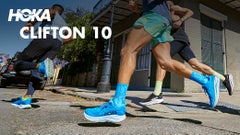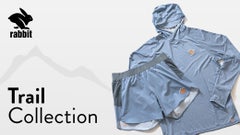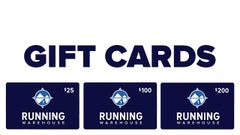Best Hair Care Tips for Female Runners
Discover how to prevent damage and maintain healthy hair while running.
Updated: October 1, 2024 by Caroline Cross
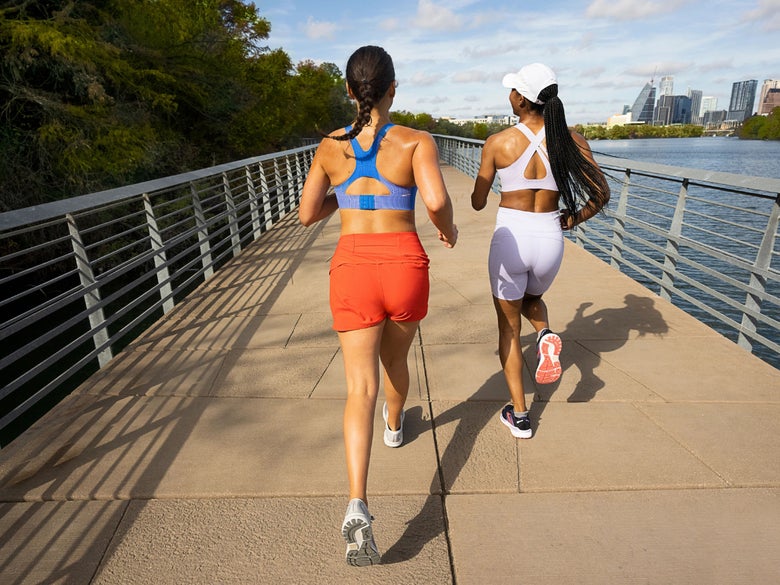
Choosing between a great hair day and the euphoria of a runner's high can sometimes be a dilemma. We have all been there. We love our daily runs and sweaty workouts, but the last thing we want to do is mess up a fresh blowout or wash our hair every day. From the sun's harsh rays and tight ponytails to frequent washing and re-styling with hot tools, the perks of an active lifestyle for female runners can weaken hair and lead to damage over time. But striving to maintain a healthy body does not mean you have to sacrifice the health of your hair. There are preventative steps you can take for softer, longer-lasting locks without having to skip out on your training. Follow our six tips on how to style and protect your hair before, during, and after your run, for healthy tresses all year round.
1. Use Sun Protection
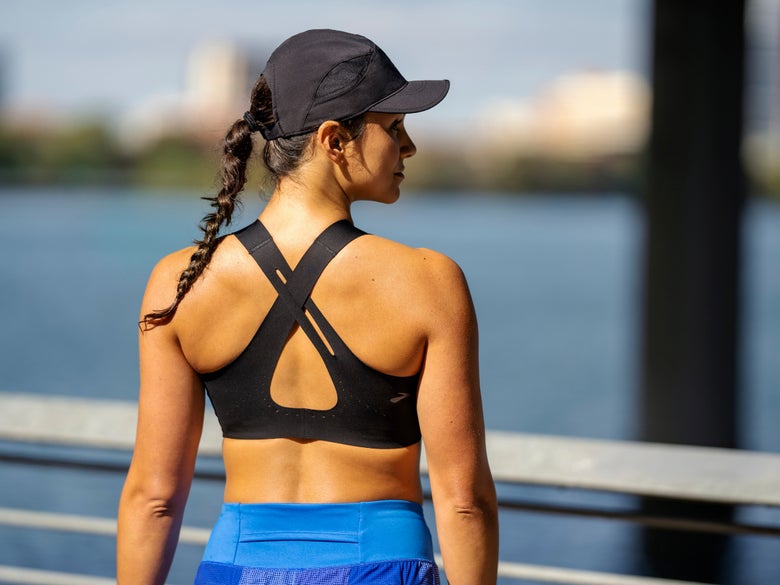
When it comes to sun protection, most people are aware of the importance of safeguarding their skin, but it's necessary to extend that same protection to your hair and scalp. Too much sun exposure can have a drying and bleaching effect on your hair, leaving it brittle and dull due to the breakdown of keratin (hair protein) from UV light. This loss of protein causes your hair to lose its lively, vibrant color and shine. While running early in the morning or later in the day when the sun's rays aren't as strong is the best way to avoid harmful UV radiation, there are additional measures you can take to protect your hair. When training outdoors, wearing a UPF-rated running hat will shield your hair while wicking away moisture. A running-specific hat is not your regular ol' baseball cap. It is lightweight and usually designed with laser-cut perforations to allow your scalp to breathe and has an internal sweatband-like liner to help wick away salty perspiration (that leads to dryness and color loss) while also sheltering you from the elements. Running under rainwater especially (which contains pollutants from the air) can weaken the hair's shaft and make your locks appear lifeless, so covering up with appropriate headwear is vital for a healthy mane.
If you want to forego wearing a hat, there are sun-protective sprays you can apply to your hair before you lace up. Look for a UVA/UVB protective treatment such as sprayable oils or mists that will absorb the ultraviolet rays, safeguarding your hair from color fading and damage. Select products made from natural and plant-derived oils, such as aloe, green-tea extract, shea butter, coconut oil, and antioxidants (vitamin E) that defend your hair from sun exposure and outdoor pollution.
2. Switch Up Your Style

Another line of defense in protecting your mane is to mix up your hairstyle each time you work out. While the traditional go-to ponytail may be quick and effortless, it can also ruin your hair, especially when wearing it in the same spot every day. A tight ponytail can cause stress to your locks by pulling on the hair follicles, thereby weakening them. If you always tie it in the same section, this can thin out the hair over time and may leave a bald spot from the breakage. Switch up your style and channel your inner Colleen Quigley by incorporating runner braids. Whether you go for the classic French braid down the back of your head or the dual Dutch braids with one on each side, you can focus on your run without dealing with any flyaway strands or tangles getting in the way. Braids also allow your scalp more access to oxygen for breathability, and as a bonus, you can let your hair down for a natural beach wavy look post-run. Alternatively, you can put your hair up in a high bun for a chic style that avoids any contact with the nape of your neck (a high-heat zone for sweat which leads to dryness). A low ponytail is also a simple yet effective way to keep your hair away from your face without the tight tug and pull of a high ponytail. Whether you opt for a bun, braids, low ponytail, or a hybrid of both, switching hairdos to avoid sweaty skin and follicle stress will help reduce breakage and minimize the risk of hair loss.
3. Wear Non-Abrasive Hair Ties

Just as cotton is known to be a runner's nemesis, an elastic tie is a primary culprit for hair damage. Tight elastic bands can cause severe pressure and tension, weakening the specific section of hair, eventually leading to breakage. Ditch the elastic bands and use hair ties made of fabric such as satin, silk, or velvet to avoid the tight, harsh hold. Non-abrasive hair ties are the ideal workout hair accessory because they can secure your hair without absorbing sweat and stressing the same section of hair. Fabric ties also help avoid headaches, breakage, or the dreaded creases and dents, which leave marks on your hair post-run. Satin scrunchies, in particular, are softer and gentler to the hair and easier to take down after your workout, gliding off smoothly instead of the tug and pull with elastic bands. Coil-shaped plastic hair ties are another popular option that is less damaging than elastic due to the unique spiral design, which allows for an even distribution of pressure and less tension on the hair. Whichever kind you choose, non-abrasive scrunchies distribute gentler pressure over a wider surface and are the least harmful way to secure your hair.
Alternatively, those with shorter hair may find headbands more practical for securing their hair while running. Sweatbands absorb moisture to minimize perspiration, keeping your hair dry while offering lightweight, soft comfort. Position the headband at the front of your hairline to prevent your roots from getting greasy, and the thicker the band is, the fewer crimps it will leave behind. While delivering on functionality, some headbands are also cute and stylish enough that you can continue wearing them post-workout.
4. Apply Quality Products

From frigid winters to scorching summers, as runners, our hair is constantly exposed to inclement weather and environmental stressors. Add salty sweat to the mix, and you have a recipe for dry, coarse hair. In addition to keeping up with monthly hair trims, staying hydrated, and eating a balanced diet (such as foods rich in omega-3, iron, protein, vitamins A, B, C, and zinc), your hair also needs nourishing products to remain vibrant and shiny. Invest in high-quality hair products, such as shampoos and conditioners without sulfates, phosphates, or parabens that are safe for natural and color-treated hair and thoroughly remove any product buildup. When applying conditioner, run it through the end of your strands to keep your hair strong and hydrated. And always dab a heat-protective, anti-frizz serum such as argan oil to lock in moisture before styling for a silky-smooth finish.
Coconut oil is also an amazing natural emulsifier, helping to add moisture to lackluster locks. It has a high content of lauric acid, which is optimal for moisturizing, conditioning, detangling your hair, and protecting your roots. The amount of coconut oil you need to apply depends on the thickness and length of your hair, but the general rule is to work a small teaspoon amount throughout the mid-length and the end of your strands (a little goes a long way). Then, tie your hair up and let the oil sit for a couple of hours before washing your hair. The longer you leave the coconut oil, the more moisture it will impart, and the softer your hair will feel to the touch. You can apply the oil before your run and rinse it off when you get back, or use it on those rest days or when running errands. Note: Be sure to select organic, cold-pressed coconut oil (either virgin or extra virgin) because they contain more nutrients than the processed version.
5. Skip Daily Washing

Recovery days are not just for your body. Your hair needs a break too! Keep your hair and scalp healthy by not over-shampooing. Washing your hair every day strips your hair of its natural oils, leaving it dry and flaky. As a result, the scalp overcompensates by producing even more oil, continuing the dreaded cycle. Break the habit and adopt a new regimen. Many hairstylists recommend washing your hair two to three times a week to avoid damage. Typically, fine or straight hair becomes oily quicker than thicker or curly hair, so depending on the texture of your hair, you can alternate the time between washes accordingly. If you are a fan of dry shampoo, be cautious about its misuse and overuse, which can clog your scalp, contributing to hair thinning and loss. For those with bangs, you can give them a quick touch-up by washing those targeted strands instead of shampooing your entire hair every day. Rinsing your scalp (between shampoo days) with cool water and lightly conditioning the ends as needed will help keep it clean and prevent dryness. This process is called "co-washing," which provides a clean rinse without stripping your hair's natural oils. The cool water helps seal the cuticles and minimize the pores of your scalp, strengthening your roots. For wavy or curly hair, relax your tresses after rinsing by spritzing a texturizing spray for a healthy, voluminous look. A texturizing spray will work with the natural feel of your hair for a frizz-free style, so you can embrace those beautiful curls and waves without needing any hot rollers.
6. Minimize Heat

Not only does over-washing dry out hair, but over-styling increases breakage as well. Using hot tools every day (blow dryer, flat iron, or curling iron) causes those dreaded and unsightly split ends and strips your hair of its pigment and moisture, leaving it brittle and dehydrated. After your workout, brush your hair for an even distribution of natural oils and allow your strands to cool off for a couple of minutes under the cold setting on your hairdryer. Otherwise, leaving the moisture from sweat to set in can dry your scalp and prevent new hair growth by clogging the hair follicles. On shampoo days, air or towel dry your hair before styling since wet hair is more prone to breakage, and always be gentle when brushing. Use a detangling hairbrush with soft bristles to prevent damage, working from the ends to your roots, and avoid the high-heat setting when blowdrying to minimize breakage. If you are still operating tools with a one-button temperature setting, then it's time for an upgrade! Blow dryers, straighteners, and curling irons with different heat settings allow you to maintain a consistent temperature without frying your hair. For wavy or curly hair, minimize heat exposure by using the diffuser attachment on your dryer instead of plugging in the straightener and curling iron afterward. The diffuser allows for better control of airflow instead of a full-force blast from the nozzle of regular hairdryers. Lastly, the benefits of sleeping on satin pillowcases are also known to perform wonders in avoiding bedhead and extending your blowout, saving you time and effort from re-styling. Overall, by taking proactive measures with the treatment and protection of your hair, you can maintain healthy tresses while still having fun chasing miles.



